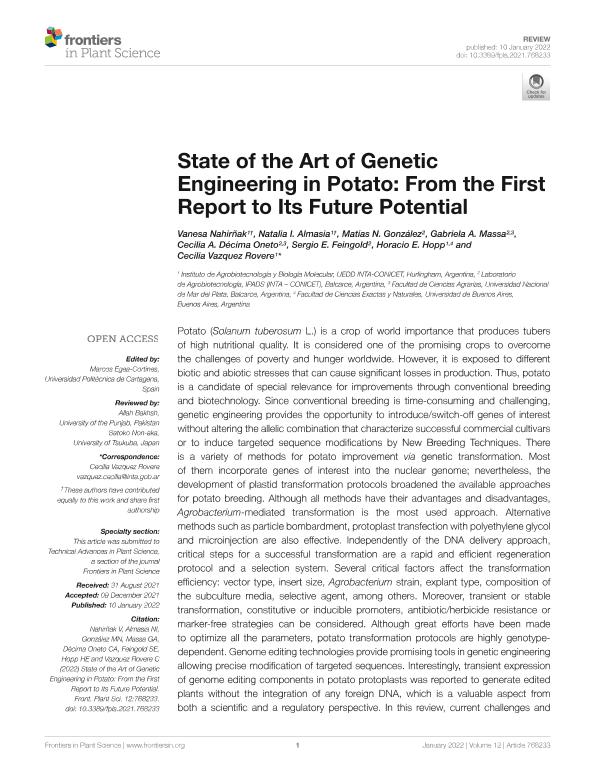Mostrar el registro sencillo del ítem
dc.contributor.author
Nahirñak, Vanesa

dc.contributor.author
Almasia, Natalia Ines

dc.contributor.author
Gonzalez, Matias Nicolas

dc.contributor.author
Massa, Gabriela Alejandra

dc.contributor.author
Décima Oneto, Cecilia Andrea

dc.contributor.author
Feingold, Sergio

dc.contributor.author
Hopp, Horacio Esteban

dc.contributor.author
Vazquez Rovere, Cecilia

dc.date.available
2023-09-01T15:00:07Z
dc.date.issued
2022-01
dc.identifier.citation
Nahirñak, Vanesa; Almasia, Natalia Ines; Gonzalez, Matias Nicolas; Massa, Gabriela Alejandra; Décima Oneto, Cecilia Andrea; et al.; State of the Art of Genetic Engineering in Potato: From the First Report to Its Future Potential; Frontiers Media S.A.; Frontiers in Plant Science; 12; 768233; 1-2022; 1-19
dc.identifier.uri
http://hdl.handle.net/11336/210165
dc.description.abstract
Potato (Solanum tuberosum L.) is a crop of world importance that produces tubers of high nutritional quality. It is considered one of the promising crops to overcome the challenges of poverty and hunger worldwide. However, it is exposed to different biotic and abiotic stresses that can cause significant losses in production. Thus, potato is a candidate of special relevance for improvements through conventional breeding and biotechnology. Since conventional breeding is time-consuming and challenging, genetic engineering provides the opportunity to introduce/switch-off genes of interest without altering the allelic combination that characterize successful commercial cultivars or to induce targeted sequence modifications by New Breeding Techniques. There is a variety of methods for potato improvement via genetic transformation. Most of them incorporate genes of interest into the nuclear genome; nevertheless, the development of plastid transformation protocols broadened the available approaches for potato breeding. Although all methods have their advantages and disadvantages, Agrobacterium-mediated transformation is the most used approach. Alternative methods such as particle bombardment, protoplast transfection with polyethylene glycol and microinjection are also effective. Independently of the DNA delivery approach, critical steps for a successful transformation are a rapid and efficient regeneration protocol and a selection system. Several critical factors affect the transformation efficiency: vector type, insert size, Agrobacterium strain, explant type, composition of the subculture media, selective agent, among others. Moreover, transient or stable transformation, constitutive or inducible promoters, antibiotic/herbicide resistance or marker-free strategies can be considered. Although great efforts have been made to optimize all the parameters, potato transformation protocols are highly genotype-dependent. Genome editing technologies provide promising tools in genetic engineering allowing precise modification of targeted sequences. Interestingly, transient expression of genome editing components in potato protoplasts was reported to generate edited plants without the integration of any foreign DNA, which is a valuable aspect from both a scientific and a regulatory perspective. In this review, current challenges and opportunities concerning potato genetic engineering strategies developed to date are discussed. We describe their critical parameters and constrains, and the potential application of the available tools for functional analyses or biotechnological purposes. Public concerns and safety issues are also addressed.
dc.format
application/pdf
dc.language.iso
eng
dc.publisher
Frontiers Media S.A.
dc.rights
info:eu-repo/semantics/openAccess
dc.rights.uri
https://creativecommons.org/licenses/by/2.5/ar/
dc.subject
AGROBACTERIUM
dc.subject
BIOTECHNOLOGY
dc.subject
GENETIC ENGINEERING
dc.subject
GENOME EDITING
dc.subject
NEW BREEDING TECHNIQUES
dc.subject
POTATO
dc.subject.classification
Biotecnología Agrícola y Biotecnología Alimentaria

dc.subject.classification
Biotecnología Agropecuaria

dc.subject.classification
CIENCIAS AGRÍCOLAS

dc.subject.classification
Tecnología GM, clonación de ganado, selección asistida, diagnósticos, tecnología de producción de biomasa, etc.

dc.subject.classification
Biotecnología Agropecuaria

dc.subject.classification
CIENCIAS AGRÍCOLAS

dc.title
State of the Art of Genetic Engineering in Potato: From the First Report to Its Future Potential
dc.type
info:eu-repo/semantics/article
dc.type
info:ar-repo/semantics/artículo
dc.type
info:eu-repo/semantics/publishedVersion
dc.date.updated
2023-08-08T12:52:45Z
dc.identifier.eissn
1664-462X
dc.journal.volume
12
dc.journal.number
768233
dc.journal.pagination
1-19
dc.journal.pais
Suiza

dc.journal.ciudad
Lausana
dc.description.fil
Fil: Nahirñak, Vanesa. Instituto Nacional de Tecnología Agropecuaria. Centro de Investigación en Ciencias Veterinarias y Agronómicas. Instituto de Agrobiotecnología y Biología Molecular. Consejo Nacional de Investigaciones Científicas y Técnicas. Oficina de Coordinación Administrativa Parque Centenario. Instituto de Agrobiotecnología y Biología Molecular; Argentina
dc.description.fil
Fil: Almasia, Natalia Ines. Instituto Nacional de Tecnología Agropecuaria. Centro de Investigación en Ciencias Veterinarias y Agronómicas. Instituto de Agrobiotecnología y Biología Molecular. Consejo Nacional de Investigaciones Científicas y Técnicas. Oficina de Coordinación Administrativa Parque Centenario. Instituto de Agrobiotecnología y Biología Molecular; Argentina
dc.description.fil
Fil: Gonzalez, Matias Nicolas. Consejo Nacional de Investigaciones Científicas y Técnicas. Centro Científico Tecnológico Conicet - Mar del Plata. Instituto de Innovación para la Producción Agropecuaria y el Desarrollo Sostenible - Instituto Nacional de Tecnología Agropecuaria. Centro Regional Buenos Aires Sur. Estación Experimental Agropecuaria Balcarce. Instituto de Innovación para la Producción Agropecuaria y el Desarrollo Sostenible; Argentina
dc.description.fil
Fil: Massa, Gabriela Alejandra. Consejo Nacional de Investigaciones Científicas y Técnicas. Centro Científico Tecnológico Conicet - Mar del Plata. Instituto de Innovación para la Producción Agropecuaria y el Desarrollo Sostenible - Instituto Nacional de Tecnología Agropecuaria. Centro Regional Buenos Aires Sur. Estación Experimental Agropecuaria Balcarce. Instituto de Innovación para la Producción Agropecuaria y el Desarrollo Sostenible; Argentina. Universidad Nacional de Mar del Plata. Facultad de Ciencias Agrarias; Argentina
dc.description.fil
Fil: Décima Oneto, Cecilia Andrea. Consejo Nacional de Investigaciones Científicas y Técnicas. Centro Científico Tecnológico Conicet - Mar del Plata. Instituto de Innovación para la Producción Agropecuaria y el Desarrollo Sostenible - Instituto Nacional de Tecnología Agropecuaria. Centro Regional Buenos Aires Sur. Estación Experimental Agropecuaria Balcarce. Instituto de Innovación para la Producción Agropecuaria y el Desarrollo Sostenible; Argentina. Universidad Nacional de Mar del Plata. Facultad de Ciencias Agrarias; Argentina
dc.description.fil
Fil: Feingold, Sergio. Consejo Nacional de Investigaciones Científicas y Técnicas. Centro Científico Tecnológico Conicet - Mar del Plata. Instituto de Innovación para la Producción Agropecuaria y el Desarrollo Sostenible - Instituto Nacional de Tecnología Agropecuaria. Centro Regional Buenos Aires Sur. Estación Experimental Agropecuaria Balcarce. Instituto de Innovación para la Producción Agropecuaria y el Desarrollo Sostenible; Argentina
dc.description.fil
Fil: Hopp, Horacio Esteban. Instituto Nacional de Tecnología Agropecuaria. Centro de Investigación en Ciencias Veterinarias y Agronómicas. Instituto de Agrobiotecnología y Biología Molecular. Consejo Nacional de Investigaciones Científicas y Técnicas. Oficina de Coordinación Administrativa Parque Centenario. Instituto de Agrobiotecnología y Biología Molecular; Argentina. Universidad de Buenos Aires. Facultad de Ciencias Exactas y Naturales; Argentina
dc.description.fil
Fil: Vazquez Rovere, Cecilia. Instituto Nacional de Tecnología Agropecuaria. Centro de Investigación en Ciencias Veterinarias y Agronómicas. Instituto de Agrobiotecnología y Biología Molecular. Consejo Nacional de Investigaciones Científicas y Técnicas. Oficina de Coordinación Administrativa Parque Centenario. Instituto de Agrobiotecnología y Biología Molecular; Argentina
dc.journal.title
Frontiers in Plant Science
dc.relation.alternativeid
info:eu-repo/semantics/altIdentifier/url/https://www.frontiersin.org/articles/10.3389/fpls.2021.768233/full
dc.relation.alternativeid
info:eu-repo/semantics/altIdentifier/doi/http://dx.doi.org/10.3389/fpls.2021.768233
Archivos asociados
